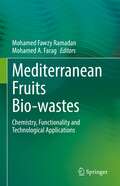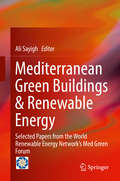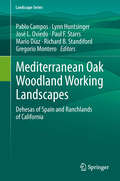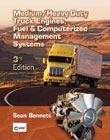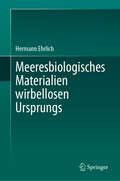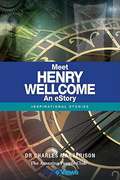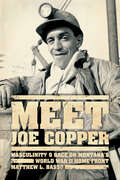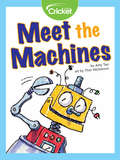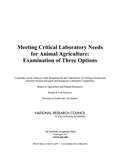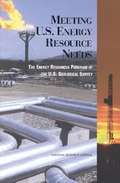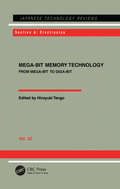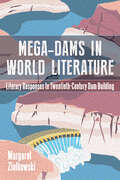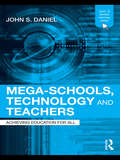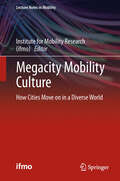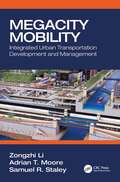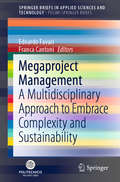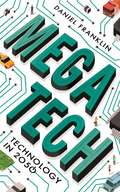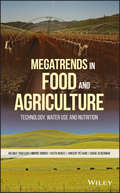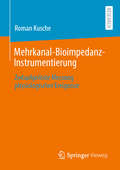- Table View
- List View
Mediterranean Fruits Bio-wastes: Chemistry, Functionality and Technological Applications
by Mohamed Fawzy Ramadan Mohamed A. FaragTraditional Mediterranean fruits (i.e., be grapes, oranges, apples, pears, peaches, cherries, plums, figs, melons, watermelon and dates) are of major commercial and nutritional value to the region. Processing of such fruits, however, results in large amounts of bio-waste material. Efficient, inexpensive and environmentally friendly use of fruit industry waste is thus highly cost-effective and minimizes environmental impact. The natural antioxidants and bioactive compounds found in Mediterranean fruit bio-wastes could play a major role in the alleged health benefits of the Mediterranean diet, and could be used in pharmaceuticals as well as novel food applications. This book presents a multidisciplinary forum of discussion on the chemistry, functional properties and health-promoting effects of bioactive compounds in Mediterranean fruit bio-wastes, as well as novel food and non-food applications. The text provides the scientific fundamentals of the health-promoting benefits and applications of Mediterranean fruit bio-wastes, reviews the relevant recovery issues and explores different techniques to develop new applications. With a diversity of perspectives, from food science to environmental chemistry and horticultural research, this volume provides comprehensive, up-to-date knowledge to researchers and industry professionals working in the areas of food waste valorization.
Mediterranean Green Buildings & Renewable Energy: Selected Papers from the World Renewable Energy Network's Med Green Forum
by Ali SayighThis book highlights scientific achievements in the key areas of sustainable electricity generation and green building technologies, as presented in the vital bi-annual World Renewable Energy Network’s Med Green Forum. Renewable energy applications in power generation and sustainable development have particular importance in the Mediterranean region, with its rich natural resources and conducive climate, making it a perfect showcase to illustrate the viability of using renewable energy to satisfy all energy needs. The papers included in this work describe enabling policies and offer pathways to further develop a broad range of renewable energy technologies and applications in all sectors – for electricity production, heating and cooling, agricultural applications, water desalination, industrial applications and for the transport sector.
Mediterranean Oak Woodland Working Landscapes
by Gregorio Montero Jose Luis Oviedo Pro Lynn Huntsinger Mario Diaz Pablo Campos Paul F Starrs Richard B StandifordThe oak tree was a boon companion as humans expanded their presence across much of the globe. While oak woodlands (Quercus spp.) come today in stunningly diverse forms, the stately dehesas of Spain and the dramatic oak-dominated ranchlands of California are working landscapes where cultivation and manipulation for a couple of millennia have shaped Mediterranean-type ecosystems into a profoundly modified yet productive environment that is sought-after by every manner of species. The grazing of wildlife and livestock in oak woodlands yields a remarkable plant and animal biodiversity, creating a mosaic of habitats and visually pleasing savannas. Added products unique to Spain such as Iberian pigs and cork, and in California multiple landowner benefits, include valued ecosystem services that allow owners, visitors, and conservation supporters to experience the benefits of woodland life. With its 15 chapters a decade in the making, this handsomely illustrated book covers key topics in oak woodland policy, ecology, and management in Spain and California, presenting new research results and reviewing an existing expert literature.
Mediterranean Protected Areas in the Era of Overtourism: Challenges and Solutions
by Ante Mandić Lidija PetrićThis book comprises studies that reflect on various influences of excessive tourism development in protected areas, and solutions designed and initiated to mitigate such challenges. A large proportion of tourism in Mediterranean destinations constitutes nature-based tourism, in particular, tourism in parks and protected areas. As a destination experiences higher intensity and density of tourism, the potential conflict between maintaining a healthy natural environment and economic development also increases. This has urged planners and decision-makers to devise and adopt innovative approaches that seek to strike a balance between tourism development and nature conservation. This book demonstrates the importance of collaboration across and beyond disciplines and of all groups of stakeholders for maximization of societal impacts and tourism-related benefits.
Medium/Heavy Duty Truck Engines, Fuel And Computerized Management Systems
by Sean BennettThe most comprehensive guide to highway diesel engines and their management systems available today, Medium/Heavy Duty Truck Engines, Fuel & Computerized Management Systems, 3E is a user-friendly resource for both entry-level and experienced technicians alike. Coverage includes the full range of truck diesels, from light duty to heavy duty, as well as the most current diesel engine management electronics used in the industry. The updated third edition features all-new discussions of series and parallel hybrid drive trains that use both electric and hydraulic hybrid technology, emerging battery and ultra capacitor technology popular in hybrid electric vehicles, expanded coverage of the new Delphi E3 injectors used in post-2007 Caterpillar, Detroit Diesel, Volvo and Mack engines, and more. With an emphasis on today's computer technology that sets it apart from any other book on the market, this is an ideal guide to working effectively in modern truck service facilities.
Medusa's Child
by John J. NanceA pilot races through the sky to stop a nuclear catastrophe in this &“compelling&” thriller by the New York Times–bestselling author of Pandora&’s Clock (People). Vivian Henry hasn&’t heard her ex-husband&’s voice in three years, but it still fills her with fear. Dangerous and brilliant, Dr. Rogers Henry is calling because he&’s dying. He offers Vivian a fortune in insurance money if she&’ll carry out one final task for him: Take the Medusa device to Washington, DC. The Medusa is his life&’s work—a thermonuclear bomb capable of knocking out all modern technology in the country—and he wants her to deliver it to the Pentagon before it falls into the wrong hands. Cargo plane captain Scott McKay is miles above the ground when the Medusa begins to speak. A recording of Dr. Henry&’s voice announces that the device is active and about to explode. With nowhere to land, Captain McKay must rely on his instincts and fly like he has never flown before to prevent a worldwide apocalypse. Medusa&’s Child proves once again that John Nance is the &“king of the modern-day aviation thriller&” (Publishers Weekly).
Meeresbiologisches Materialien wirbellosen Ursprungs
by Hermann EhrlichDas Buch Das Werk ist eine Quelle für modernes Wissen über Biomineralisation, Biomimetik und bioinspirierte Materialwissenschaft in Bezug auf wirbellose Meerestiere. Der Autor liefert die kohärenteste Analyse der Natur, des Ursprungs und der Entwicklung von Biokompositen und Biopolymeren, die aus der großen Vielfalt der wirbellosen Meeresorganismen isoliert und in deren ungewöhnlichen Strukturformationen beobachtet wurden. Das grundlegende Format ist das eines großen Übersichtsartikels, mit großzügiger Verwendung von Verweisen auf die Originalliteratur. Das Buch enthält eine Fülle neuer und neu zusammengestellter Informationen, darunter Dutzende von bisher unveröffentlichten Bildern einzigartiger mariner Lebewesen und Strukturen vom Nano- bis zum Mikrobereich, einschließlich hochauflösender Raster- und Transmissionselektronenmikroskopaufnahmen. Das Material ist sowohl nach biologischen (Phyla) als auch nach funktionellen Gesichtspunkten geordnet. Es wird eine Klassifizierung der biologischen Materialien marinen Ursprungs vorgeschlagen und diskutiert. Ein Großteil der einschlägigen Daten ist in Tabellen organisiert, und es wird ausgiebig Gebrauch von elektronenmikroskopischen Aufnahmen und Strichzeichnungen gemacht. Mehrere moderne Themen, wie z.B. "Biomineralisierungs-, Demineralisierungs- und Remineralisierungsphänomene" oder "Phänomene der mehrphasigen Biomineralisation", werden ausführlich diskutiert. Traditionell werden aktuelle Konzepte wie die hierarchische Organisation von Biokompositen und Skelettstrukturen, strukturelle Biogerüste, Bioskulpturierung, Biomimetismus und Bioinspiration als Werkzeuge für das Design innovativer Materialien sowohl aus biologischer als auch aus materialwissenschaftlicher Sicht anhand zahlreicher einzigartiger Beispiele marinen Ursprungs kritisch analysiert. Diese Monographie gibt einen Überblick über die wichtigsten Fortschritte auf dem Gebiet der marinen Biomaterialien und zeigt mehrere Ansätze auf, die von verschiedenen Labors eingeführt und erforscht werden."
Meet Charles Darwin - An eStory
by Charles MargerisonMeet Charles Darwin, responsible for the theory of natural selection and author of On Origin of the Species. Darwin is arguably one of the most influential characters in world history, in that he redefined so many pre-conceived ideas. He was far ahead of his time. His amazing life comes alive through BioViews. You can follow the young Darwin from his early years, when his mother died, to his medical studies where his curiosity in natural order and development sent him off on explorations that would ultimately change the way the world is regarded.A BioView® is a short biographical story, similar to an interview. These unique audio stories provide an easy way of learning about amazing people who made major contributions to our world.
Meet Henry Wellcome - An eStory
by Charles MargerisonMeet Henry Wellcome. Discover his amazing life story in this unique audio story from The Amazing People Club. He may have saved your life with the medicines he developed and produced. Henry willed his entire fortune to further development and research to The Wellcome Trust, which is one of the largest biomedical charities in the world. Travel with Henry Wellcome from the log cabin in which he was born in Wisconsin on his epic journeys around the world, driven by his thirst for knowledge and insatiable curiosity. Henry Wellcome's story comes to life through BioViews®. These are short biographical narratives, similar to interviews. They provide an easy way of learning about amazing people who made major contributions and changed our world.
Meet Joe Copper: Masculinity and Race on Montana's World War II Home Front
by Matthew L. BassoOC I realize that I am a soldier of production whose duties are as important in this war as those of the man behind the gun. OCO So began the pledge that many home front men took at the outset of World War II when they went to work in the factories, fields, and mines while their compatriots fought in the battlefields of Europe and on the bloody beaches of the Pacific. The male experience of working and living in wartime America is rarely examined, but the story of men like these provides a crucial counter-narrative to the national story of Rosie the Riveter and GI Joe that dominates scholarly and popular discussions of World War II. In "Meet Joe Copper," Matthew L. Basso describes the formation of a powerful, white, working-class masculine ideology in the decades prior to the war, and shows how it thrivedOCoon the job, in the community, and through union politics. Basso recalls for us the practices and beliefs of the first- and second-generation immigrant copper workers of Montana while advancing the historical conversation on gender, class, and the formation of a white ethnic racial identity. "Meet Joe Copper" provides a context for our ideas of postwar masculinity and whiteness and finally returns the men of the home front to our reckoning of the Greatest Generation and the New Deal era.
Meet Me in the Middle: A VeeFriends Book
by Gary VaynerchukNew York Times bestselling author, entrepreneur, and internet personality Gary Vaynerchuk gives kids a jump-start on getting ahead in Meet Me in the Middle, an all-original picture book featuring his beloved VeeFriends characters!With its unique two-in-one flip-book format, Meet Me in the Middle encourages young readers to see how different the world looks from another point of view. Start the book from the front and readers will learn about Eager Eagle’s day. Flip it over and readers will see the same story from Patient Pig’s perspective. It’s a fun story about how real success comes from seeing how the other side does it.Inspired by the lessons in the million-copy bestselling book Twelve and a Half, Meet Me in the Middle gives parents and educators a way to talk to kids about empathy, problem solving, and compromise—the essential keys to success, at any age!
Meet Your Bike
by Liz HuyckA bicycle is a fun and efficient way to get from one place to another. But have you ever wondered what parts make up a bike? Some bikes have hand lever brakes while others do not. Riders with more experience usually set their seats a bit higher than those with less experience. Learn more about the functions of a bike's moving parts!
Meet the Machines
by Amy TaoLearn all about machines, which is any tool that makes movement easier.
Meeting Critical Laboratory Needs for Animal Agriculture
by National Research Council Board on Agriculture and Natural Resources Division on Earth and Life Studies Board on Life Sciences Committee on an Analysis of the Requirements and Alternatives for Foreign Animal and Zoonotic Disease Research and Diagnostic Laboratory CapabilitiesOutbreaks of animal disease can have catastrophic repercussions for animal agriculture, the food supply, and public health. Rapid detection, diagnosis and response, as well as development of new vaccines, are central to mitigating the impact of disease outbreaks. The proposed National Bio- and Agro-Defense Facility (NBAF) is a next-generation laboratory for animal disease diagnostics, training, and research that would provide core critical components for defense against foreign animal and zoonotic disease threats. But it will be a major investment with estimated construction costs of $1.14 billion, as currently designed. Meeting Critical Laboratory Needs for Animal Agriculture: Examination of Three Optionsdiscusses the laboratory infrastructure needed to effectively address the threat posed by animal and zoonotic diseases and analyzes three options for creating this infrastructure: building NBAF as currently designed, building a scaled-back version of the NBAF, or maintaining current research capabilities at Plum Island Animal Disease Center while leveraging biosafety level-4 large animal capabilities at foreign laboratories.
Meeting U.S. Energy Resource Needs: The Energy Resources Program of the U.S. Geological Survey
by Panel to Review the U.S. Geological Survey's Energy Resources ProgramA report on The Energy Resources Program of the U.S. Geological Survey
Meeting the Energy Needs of Future Warriors
by Committee on Soldier Power/Energy SystemsThe central characteristic of the evolution of the combat soldier in recent years is an increasingly sophisticated array of sensing, communications, and related electronics for use in battlefield situations. The most critical factor for maintaining this evolution will be the development of power supply systems capable of operating those electronics effectively for missions up to 72 hours long. To address the challenge, it is important that new approaches be sought on how to integrate and power these electronics. To assist in addressing this problem, the Army requested the National Research Council to review the state of the art and to recommend technologies that will support the rapid development of effective power systems for the future warrior. This report presents the results of that review. It provides an assessment of various technology options for different power level requirements, power system design, and soldier energy sinks. The report also describes future design concepts, focusing on low-power systems. Recommendations for technology development and system design are presented.
Mega-Bit Memory Technology - From Mega-Bit to Giga-Bit: From Mega-Bit to Giga-Bit (Japanese Technology Reviews Ser. #Vol. 32.)
by Hiroyuki TangoThis book describes LSI process technology, and focuses on the rapid progress of state-of-the-art dynamic random access memory (DRAM) process technologies—the longstanding technology driver of Si ULSI—as they advance from the 1 Kbit to the Gbit DRAM era.
Mega-Dams in World Literature: Literary Responses to Twentieth-Century Dam Building
by Margaret ZiolkowskiMega-Dams in World Literature reveals the varied effects of large dams on people and their environments as expressed in literary works, focusing on the shifting attitudes toward large dams that emerged over the course of the twentieth century. Margaret Ziolkowski covers the enthusiasm for large-dam construction that took place during the mid-twentieth-century heyday of mega-dams, the increasing number of people displaced by dams, the troubling environmental effects they incur, and the types of destruction and protest to which they may be subject. Using North American, Native American, Russian, Egyptian, Indian, and Chinese novels and poems, Ziolkowski explores the supposed progress that these structures bring. The book asks how the human urge to exploit and control waterways has affected our relationships to nature and the environment and argues that the high modernism of the twentieth century, along with its preoccupation with development, casts the hydroelectric dam as a central symbol of domination over nature and the power of the nation state. Beyond examining the exultation of large dams as symbols of progress, Mega-Dams in World Literature takes a broad international and cultural approach that humanizes and personalizes the major issues associated with large dams through nuanced analyses, paying particular attention to issues engendered by high modernism and settler colonialism. Both general and specialist readers interested in human-environment relationships will enjoy this prescient book.
Mega-Schools, Technology and Teachers: Achieving Education for All (Open and Flexible Learning Series)
by Sir John DanielEducation for All (EFA) has been a top priority for governments and intergovernmental development agencies for the last twenty years. So far the global EFA movement has placed its principal focus on providing quality universal primary education (UPE) for all children by 2015. The latest addition to The Open and Flexible Learning series, this book addresses the new challenges created by both the successes and the failures of the UPE campaign. This book advocates new approaches for providing access to secondary education for today’s rapidly growing population of children and young adults and examines: the creation and expansion of Mega-Schools, which combine distance learning and community support and have a proven track record of increasing access at scale how to prepare the ten-million new teachers that are required to achieve Education for All by 2015 by focusing on classroom-based in-service training strategies for using technology to scale up distance education cost-effectively the creation of a twenty-first century educational ecosystem that integrates open schooling and teacher education with communities and their school systems successful examples of open schools and teacher education programmes operating at scale around the world. Readers will be delighted to find that Sir John Daniel, bestselling Routledge author of Mega Universities and Knowledge Media, delivers another insightful and practical book on educational technology. Mega-Schools, Technology and Teachers will be of interest to all who are concerned by the central educational challenge of our times: providing secondary education to tens of millions of young people around the world.
Megacity Mobility Culture: How Cities Move on in a Diverse World
by Institute for Mobility ResearchWhat determines how cities move on? The ever-increasing challenges to urban mobility come in many forms, and approaches to address them range from the technically ingenious to attempts to change travel behaviour. Key amongst factors essential to the success of any such approach is whether the urban environment proves to be fertile ground for the desired progress. Another vital determinant of success is how well individual measures to engineer the transport system interact with other developments. This leads to the principal subject of Megacity Mobility Culture: the basic principles that determine the paths along which cities move. This book demonstrates that the concept of 'mobility culture' provides a framework for understanding the development of urban transport which transcends the boundaries between academic disciplines. Based on a discussion of the diversity of megacities worldwide, it provides help in navigating the complexity of megacity mobility culture. Experts from megacities around the world each take the reader on a journey to their own city and its mobility culture, giving a deeper insight into the unique evolutionary paths of mobility that these places have taken, and what lies before them. Whilst acknowledging the overwhelming diversity of cities worldwide, the authors also identify common denominators behind the evolution of urban transport systems - seven temperaments which are found in a unique mix in any given city, defining the character of its mobility culture. The Institute for Mobility Research is a research facility of the BMW Group. It deals with future developments and challenges relating to mobility across all modes of transport, with automobility being only one aspect among many. Taking on an international perspective, ifmo's activities focus on social science and sociopolitical, economic and ecological issues, but also extend to cultural questions related to the key challenges facing the future of mobility. The work of the Institute is supported by an interdisciplinary board of renowned scientists and scholars, and by representatives of BMW, Deutsche Bahn, Lufthansa, MAN, Siemens and The World Bank.
Megacity Mobility: Integrated Urban Transportation Development and Management
by Zongzhi Li Samuel R. Staley Adrian T. MooreWorld population growth and economic prosperity have given rise to ever-increasing demands on cities, transportation planning, and goods movement. This growth, coupled with a slower pace of transportation capacity expansion and deteriorated facility restoration, has led to rapid changes in the transportation planning and policy environment. These stresses are particularly acute for megacities where degradation of mobility and facility performance have reached alarming rates. Addressing these transportation challenges requires innovative solutions. Megacity Mobility grapples with these challenges by addressing transportation policy, planning, and facilities in a multimodal context. It discusses innovative short- and long-term solutions for meeting current and future mobility needs for the world’s most dynamic cities by addressing the influence of urban land use on mobility, 3D spiderweb transportation planning, travel demand management, multimodal transportation with flexible capacity, efficient capacity utilization driven by new technologies, innovative transportation funding and financing, and performance-based budget allocation using asset management principles. It discusses emerging issues, highlights potential challenges affecting proposed solutions, and provides policymakers, planners, and transportation professionals a road map to achieving sustainable mobility in the 21st century. Zongzhi Li is a professor and the director of the Sustainable Transportation and Infrastructure Research (STAIR) Center at Illinois Institute of Technology (IIT). Adrian T. Moore is vice president of policy at Reason Foundation in Washington, D.C., with focuses on privatization, transportation and urban growth, and more. Samuel R. Staley is the director of the DeVoe L. Moore Center in the College of Social Sciences and Public Policy at Florida State University.
Megaproject Management: A Multidisciplinary Approach to Embrace Complexity and Sustainability (SpringerBriefs in Applied Sciences and Technology)
by Franca Cantoni Edoardo FavariThe book investigates the various aspects characterizing Megaprojects from numerous perspectives and by integrating different disciplines: engineering, economics, business organization, human resource management, law, etc. It represents the first output of MeRIT (the Megaproject Research Interdisciplinary Team), and focuses on the intrinsic and unavoidable complexity of Megaprojects. The chapters have intentionally not been standardized, and humanistic topics are not separated from technical ones: this way of reading and interpreting Megaprojects through the cross-pollination of various disciplines reflects the MeRIT approach. Addressing the complexity involved in Megaprojects requires the use of a hermeneutic circle of sorts: understanding the project as a whole is achieved by referring to the specific parts, while each part can only be understood in relation to the whole. This circular approach appears to be the only one applicable to Megaprojects: no final destination, no final synthesis can be achieved. This volume consists of eight chapters written by researchers in law, economics, sociology, business organization, engineering, architecture and landscaping. The topics covered will be relevant to researchers, practitioners involved in the development of Megaprojects, and policymakers at the EU level.
Megatech: Technology in 2050
by Daniel FranklinWhat will the world of technology look like in 2050? And how will it affect the way we live? These are the big questions explored in MEGATECH: TECHNOLOGY IN 2050, a collection of thought-provoking insights imagining how big developments in technology might shape the future.The book invites us on a journey to the future, contemplating where and how far technology might take us. The industry's biggest leaders, academics, writers, and journalists—including Dr. Frank Wilzcek, Alastair Reynolds, and Melinda Gates—examine what the impact of technology might be in 2050 and consider the policies we might need, both to make the most of future opportunities and to tackle the environmental, economic, and social challenges ahead.MEGATECH is a book of big, bold ideas from a stellar line-up of prominent players in the tech world. It is required reading for anyone engaged with the interrelationships between technology, innovation, business, politics, and society.
Megatrends in Food and Agriculture: Technology, Water Use and Nutrition
by David Zilberman Michel Dubois Helmut Traitler Keith Heikes Vincent PetiardHighlights and examines the growing convergence between the food and agricultural industries—the technological, environmental, and consumer-related drivers of this change, and the potential outcomes This is the first book of its kind to connect food and the food industry with agriculture, water resources, and water management in a detailed and thorough way. It brings together a small community of expert authors to address the future of the food industry, agriculture (both for plants and animals), and water—and its role in a world of increasing demands on resources. The book begins by highlighting the role of agriculture in today's food industry from a historical perspective—showing how it has grown over the years. It goes on to examine water management; new ways of plant breeding not only based on genetic modification pathways; and the attention between major crops (soy, corn, wheat) and so-called "orphan crops" (coffee, cocoa, tropical fruits). The book then turns towards the future of the food industry and analyzes major food trends, the new food, and "enough" food; discusses possible new business models for the future food industry; and analyzes the impact that the "internet of everything" will have on agriculture and the food industry. Finally, Megatrends in Food and Agriculture: Technology, Water Use and Nutrition offers scenarios about how agriculture, food, and the food industry might undergo some radical transformations. Assesses the evolution of food production and how we arrived at today's landscape Focuses on key areas of change, driven by both innovation and challenges such as new technologies, the demand for better nutrition, and the management of dwindling resources Highlights the role of better-informed consumers who demand transparency and accountability from producers Is written by industry insiders and academic experts Megatrends in Food and Agriculture: Technology, Water Use and Nutrition is an important resource for food and agriculture industry professionals, including scientists and technicians as well as decision makers, in management, marketing, sales, and regulatory areas, as well as related NGOs.
Mehrkanal-Bioimpedanz-Instrumentierung: Zeitaufgelöste Messung physiologischer Ereignisse
by Roman KuscheZur Entwicklung neuer biomedizinischer Messverfahren werden theoretische Ansätze, technische Umsetzungen und Charakterisierungen von Mehrkanal-Bioimpedanz-Instrumentierungen vorgestellt. Diese ermöglichen die simultane Messung der passiven elektrischen Gewebeeigenschaften an unterschiedlichen Körperstellen. Es wird gezeigt, wie aus den abgeleiteten Signalen Informationen bezüglich des Herz-Kreislauf-Systems gewonnen werden können, wobei insbesondere auf die Impedanz-Plethysmographie eingegangen wird. Bei dem zweiten behandelten Anwendungsschwerpunkt handelt es sich um die Detektion von Muskelkontraktionen mittels Impedanz-Myographie, insbesondere zur Ansteuerung von Prothesen.
